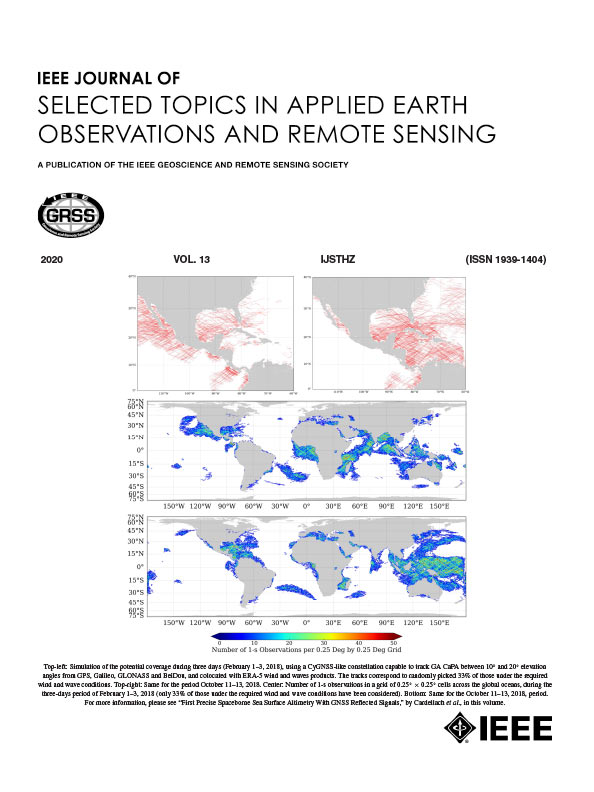Simulation and Validation of Real-Time UAV-Based GNSS-R Altimetry Across Diverse Landforms
IF 5.3
2区 地球科学
Q1 ENGINEERING, ELECTRICAL & ELECTRONIC
IEEE Journal of Selected Topics in Applied Earth Observations and Remote Sensing
Pub Date : 2025-08-25
DOI:10.1109/JSTARS.2025.3602102
引用次数: 0
Abstract
Accurate measurement of land surface elevation is essential for applications, such as terrain mapping, environmental monitoring, and ecological assessment. However, conventional spaceborne and ground-based techniques face challenges in achieving both high accuracy and real-time performance. To address these limitations, this work proposes a BeiDou-based UAV global navigation satellite system reflectometry altimetry system capable of delivering real-time elevation estimates at a 5 Hz sampling rate. The system integrates a compact, low-power receiver with a real-time correction framework, thereby eliminating the need for postprocessing. Performance was evaluated through three experiments involving variable flight altitudes (10–110 m), low signal-to-noise ratio (SNR) conditions, and complex terrain scenarios (1300–1550 m). The system achieved an accuracy of 1.5 m under both low-altitude and low-SNR conditions, and approximately 1.854 m in complex terrain scenarios. These consistent results across diverse conditions indicate the system’s robustness and generalizability. To support realistic signal modeling, a 12.5 m resolution ALOS digital elevation model and the GSS-9000 simulator were employed. In addition, terrain undulation, vegetation characteristics, and surface roughness were incorporated into the modeling process. The results demonstrate that the system has strong potential for practical use in terrain mapping and disaster monitoring applications.基于无人机的不同地形实时GNSS-R测高仿真与验证
精确测量地表高程对于地形测绘、环境监测和生态评价等应用至关重要。然而,传统的星载和地基技术在实现高精度和实时性方面面临挑战。为了解决这些限制,本工作提出了一种基于北斗的无人机全球导航卫星系统反射测高系统,能够以5 Hz采样率提供实时高程估计。该系统集成了一个紧凑、低功耗的接收器和实时校正框架,从而消除了后处理的需要。通过不同飞行高度(10-110 m)、低信噪比(SNR)条件和复杂地形(1300-1550 m)三个实验来评估性能。该系统在低空和低信噪比条件下的精度均为1.5 m,在复杂地形情况下的精度约为1.854 m。这些在不同条件下的一致结果表明了系统的鲁棒性和泛化性。为了支持真实的信号建模,采用了12.5 m分辨率的ALOS数字高程模型和GSS-9000模拟器。此外,地形起伏、植被特征和表面粗糙度也被纳入建模过程。结果表明,该系统在地形测绘和灾害监测方面具有很强的实际应用潜力。
本文章由计算机程序翻译,如有差异,请以英文原文为准。
求助全文
约1分钟内获得全文
求助全文
来源期刊
CiteScore
9.30
自引率
10.90%
发文量
563
审稿时长
4.7 months
期刊介绍:
The IEEE Journal of Selected Topics in Applied Earth Observations and Remote Sensing addresses the growing field of applications in Earth observations and remote sensing, and also provides a venue for the rapidly expanding special issues that are being sponsored by the IEEE Geosciences and Remote Sensing Society. The journal draws upon the experience of the highly successful “IEEE Transactions on Geoscience and Remote Sensing” and provide a complementary medium for the wide range of topics in applied earth observations. The ‘Applications’ areas encompasses the societal benefit areas of the Global Earth Observations Systems of Systems (GEOSS) program. Through deliberations over two years, ministers from 50 countries agreed to identify nine areas where Earth observation could positively impact the quality of life and health of their respective countries. Some of these are areas not traditionally addressed in the IEEE context. These include biodiversity, health and climate. Yet it is the skill sets of IEEE members, in areas such as observations, communications, computers, signal processing, standards and ocean engineering, that form the technical underpinnings of GEOSS. Thus, the Journal attracts a broad range of interests that serves both present members in new ways and expands the IEEE visibility into new areas.

 求助内容:
求助内容: 应助结果提醒方式:
应助结果提醒方式:


